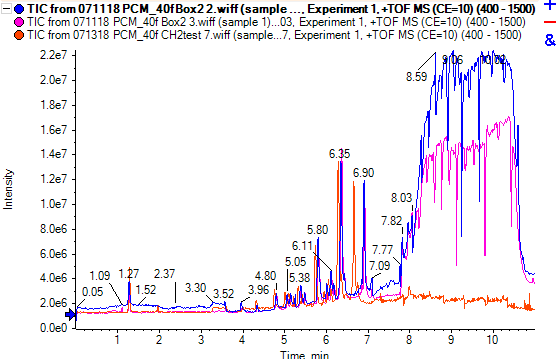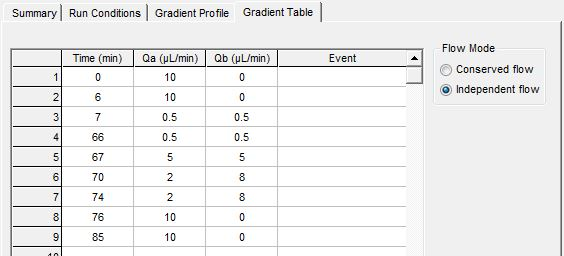Using the dual gradient system, the nanoLC 425 system can be configured such that the trap can be washed to waste rather than through the column and into the mass spectrometer. This workflow can be performed with either nanoflow or microflow chromatography.

Figure 1. Example of washing the late-eluting compounds to waste.
In a typical trap elute workflow, the isocratic load pump is used to load the sample onto the trap in the Load position and any salts are washed through to waste with aqueous. The trap valve is then switched to Inject position and the analytical gradient is used to elute the analytes off the trap, through the analytical column and then into the MS for analysis.
In this workflow, the second gradient channel (e.g Gradient 2) will be used instead of the isocratic Load pump to load the samples onto the trap with high aqueous. After loading, the trap valve switches to inject and the analytes are eluted using the analytical gradient. What is novel to this workflow is that after the bulk of the analytes have been eluted off the trap (say 35% B) then the trap valve is switched back to the Load position for washing. Because it is a gradient channel, this can now be used to run an organic wash step through the trap column in the Load position to waste at the end of the peptide elution gradient, such that hydrophobic analytes will be washed to waste. An example is shown below for running the PepCalMix sample with the normal microflow set-up (pink and blue traces) and the offline trap wash strategy (orange trace).

Figure 2. Trap elute configuration for off-line trap washing.
The only change in configuration that is required is that the second gradient channel (not being used for the analytical column) is converted to a microflow channel using the Low Micro Flow Module and the line to the AS valve is moved from the Load pump to this Gradient channel (e.g. Gradient 2 in this example).
See Appendix for a table of parts required for this configuration.
Offline trap washing
In this example, Gradient 2 will be used for trap loading and washing and Gradient 1 will be used as the analytical gradient. The Trap elute configuration will be basically the same as the normal trap elute configuration however the 50 µm ID PeekSIL line from the pump to the Autosampler valve will be connect to Gradient 2 rather than the Loading pump.
Autosampler method
Create a µL pick-up autosampler method according to the method shown below.

- Set up the LC system in the normal trap elute configuration, but instead of using the Loading Pump, connect the Gradient 2 pump to Port 1 on the autosampler valve (Figure 2).
- Build the AS method according to the method above.
- As with a typical trap elute method, the sample is first picked up (Row 6) and loaded on the trap. Then Gradient 2 is started to wash the trap with aqueous for 5 mins (Row 7). After washing is complete, Gradient 1 is started and the ISS-A valve is switched into Inject mode (Row 10) to start eluting the peptides onto the column into the MS. This is the same as a typical trap elute method.
- The key change here is Row 13 and 14. Here the wait step must be set up to time the switching of the ISS-A valve back to the Load position to coincide with the completion of the elution of the key part of the gradient off the trap (~35% B for peptides). This must be manually confirmed but should be roughly the duration of the gradient from the analytical column.
Gradient 2 pump method – trap washing

- With this method, the trap will first be washed with aqueous solvent for a user defined time with the ISS-A valve in the Load position. (Row 1-2). This should be slightly longer than the wait step defined in the AS3 method (Row 9) to ensure the pumps flow at high aqueous and completely load and desalt the trap.
- After washing the ISS-A valve is switched to Inject and peptides are eluted from the trap through the column into the MS. During this time, the flow rate on Gradient 2 can be dropped to a low flow to conserve solvent. (Row 3-4) Typically this is also run at 50% B. To do this the pump must be programmed in Independent flow mode as shown above.
- After elution of peptides off the trap is complete by Gradient 1, the flow rate on Gradient 2 is increased back up and increased to higher organic (Row 5). The ISS-A valve is switched back to Load position by the AS method (Row 14 in the AS3 method).
- Now the Gradient 2 flow is going through the trap to waste and the organic solvent can be ramped up and down to wash the trap. (Row 6-7)
- The final steps should be at aqueous to re-equilibrate the trap for the next sample.
Gradient 1 method – peptide elution

- With this Gradient 1 method, the peptides are eluted from the trap, through the column into the MS. The method is started after the washing of the trap by the Gradient 2 method is complete. (Row 2 in the Gradient 2 method and Row 11 in the AS method)
- This method is programmed per the normal elution method. (Row 1-2)
- The ISS-A valve is switched back to Load after peptide elute (at Row 2) then the column can be lightly washed with Gradient 2. (Row 3-4)
- Column is re-equilibrated to aqueous conditions (Rows 5-6) to be ready for the next injection.
Parts list.
Below is a table of all the parts needed to perform the nanoflow test. All part numbers for SCIEX unless otherwise indicated.
| Part number | # needed | Item | Description |
| 5018237 | 1 | Ekspert nanoLC 400, Low micro flow module
for 1-10 µL/min |
For performing off-line trap washing with both microflow and nanoflow, this extra flow module will be needed for trap washing. |
RUO-MKT-18-8218-A



 Contact Support
Contact Support
0 Comments